Common european currency
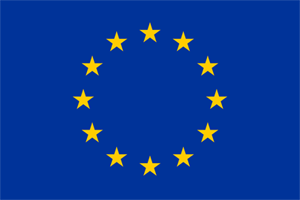
E-day was January 1, 2002. It was the dawn of a new era, opening a new chapter in European history as twelve of the countries in the European Union issued their new euro banknotes and coins. E-day was the culmination of a six year programme to design and print over 14 billion euro banknotes and mint 50 billion euro coins. A mammoth undertaking. Around ten billion banknotes were put into circulation immediately, replacing national banknotes, while the rest were held in reserve to replenish stocks. The banknotes were issued in seven denominations: €5, €10, €20, €50, €100, €200 and €500 and the new coins came in eight denominations - 1, 2, 5, 10, 20 and 50 cent, and €1 and €2. One euro is equal to 100 cents. The symbol chosen for the new currency (€) is inspired by the Greek letter "epsilon", which is the first letter of the word Europe (ancient Greek name found in Greek mythology). The two parallel lines indicate euro's stability. The official abbreviation for the new currency, which has also been registered with the International Standards Organization (ISO) is EUR and can be used in financial, commercial and business activities. Euro coinsThe eight euro coins vary in size, weight, material, colour and thickness to facilitate recognition by the blind and the partially sighted. In addition the finish on the edges of the euro coins is different for each consecutive denomination. The coins have a common European side, designed by Luc Luycx of the Royal Belgian Mint. These common sides feature three designs, each centred on a different map of Europe against the background of the 12 stars of the European Union flag. The map on the three lowest denominations - 1, 2 and 5 cent - shows Europe in relation to the world. The 10, 20 and 50 cent coins represent the European Union as a group of individual countries. To emphasise the unity of the European Union, the same group is shown as an integrated whole on the €1 and €2 coins. 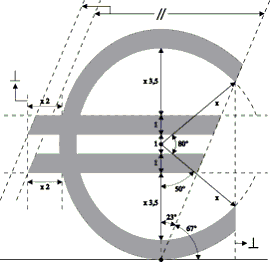 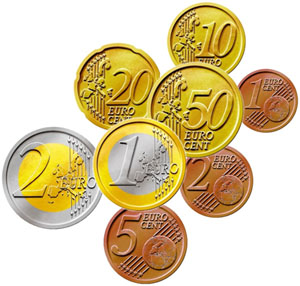 All coins are valid throughout the euro area, irrespective of the national sides of the coins. The national sides are different in each of the 12 countries and depict familiar national motifs. The high-value coins, the €1 and €2 coins, are bimetallic, with two different metals fused together, clearly showing two different colours. Their production process involves the very latest technology, which makes them difficult to counterfeit, as does the lettering around the edge of the €2 coin. A quality management system has been put in place to ensure that the euro coins will be interchangeable throughout the euro area. They will conform to the common standards necessary for use in all vending machines. Though they are not members of the EU, Monaco, San Marino and Vatican City (but not Andorra) also have euro coins featuring a national side, but these only occasionally end up in general circulation as their scarcity leads to greater interest from coin collectors. The coins from Monaco feature the royal family's coat of arms and seal and the portrait of the current ruler, Prince Rainier III. Those from San Marino have various towers and public buildings from the small nation on them as well as the national coat of arms and the Vatican coins present the portrait of Pope John Paul II. Having coins with the effigy of a religious leader accepted as legal tender caused some controversy in certain countries such as France. As for Andorra, it has secured the right to mint its own national reverse from the EU since the country will join the EU tax evasion system in 2005. For the time being, the authority to mint coins has been transfered from the Bishop of Urgell to the andorran goverment recently. Euro pictures & specificationsThe design process for the coins started in spring 1996. During the Informal Ecofin Council in Verona, the european governments decided that the euro coins will have a European side and a national side. Member States were free to choose the national side (preferably with the display of twelve stars on it) and the Commission organised a competition at European level to select the design for the common face of the euro coins. The design competition was limited to three themes:
National selections were made by all Member States, except Denmark. In March 1997, a European jury of experts from a wide variety of occupational sectors (art, design, consumer representatives etc) chose the nine best series out of a total of 36. Mint Directors were consulted in parallel on the industrial feasibility of the various designs. An opinion poll was also organised by the Commission throughout the European Union among the general public and professional organisations representing the major coin-using sectors. The winning series were chosen by the Finance Ministers, and confirmed by the Heads of State and Government at the European Council of Amsterdam. The winner of the competition was designer Luc Luycx, a 39 year old graphic designer of the Belgian Royal Mint. The winning design came first in the opinion poll, with nearly 64% of positive responses. The design on the common side of the euro coins features a representation of Europe, as opposed to a map of Europe. The 1, 2 and 5 cents show Europe in the world. The 10, 20 and 50 cents illustrate the Union as a group of nations. The 1 and 2 euro coins illustrate a Europe without frontiers. Only islands of over 2500km2 and archipelagos of over 5000km2 were included in the design. The design of the euro common side was changed, at the 2666th Council meeting of Economic and Financial Affairs in Luxembourg on June 7, 2005. The decision reflected the enlargement of the Eurozone and the new country - members are depicted on the the 1, 2 euro and 10, 20, 50 cent coins. | |||||
Bi-colourWhen determining the coin metals for the highest denominations of 1 and 2 Euro, much attention was paid to the safety marks. Considering the value of these coins it is important to consider that they are difficult to forge. The choice finally landed on coin plates that are made up of several metal alloys. These materials consist of a core of a certain metal and a ring of another metal, both with a different coloration. Coins of this composition are called 'bi-colour coins'. The production of bi-colour coins are a technical innovation of the last decades. |
|||||
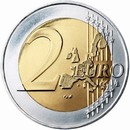 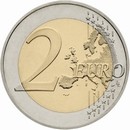  EUR 2 |
Diameter (mm): 25.75 Thickness (mm): 2.20 Weight (g): 8.50 Shape: Round Colour: Outer part: white; inner part: yellow Composition: Outer part: copper-nickel; inner part: three layers: nickel brass, nickel, nickel brass Edge: Edge lettering, fine milled
|
||||
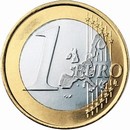 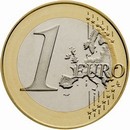  EUR 1 |
Diameter (mm): 23.25 Thickness (mm): 2.33 Weight (g): 7.50 Shape: Round Colour: Outer part: yellow; inner part: white Composition: Outer part: nickel brass; inner part: three layers: copper-nickel, nickel, copper-nickel Edge: Interrupted milled
|
||||
Nordic GoldFor the choice of coin metals for the eight Euro denominations a plea was made to avoid the application of nickel in so far as possible in connection with commonly occurring nickel allergies. Before the introduction of the Euro series, around 75% of the coins in the European Union included nickel. By reducing the use of nickel to the coins of 1 and 2 Euro, now only 8% of all Euro coins contain nickel. For the three middle denominations, 10, 20 and 50 Euro cents, a nickel free metal sort with a golden colour was sought after. The choice finally fell on a relatively new material: Nordic Gold.Nordic Gold was originally developed more than 10 years ago for the Swedish Mint and is today being used for the Swedish 10 Crown coin. It is a brass alloy, made up from more than 89% of copper, 5% aluminium and 1% zinc. By adding aluminium the material gets its pretty golden shine. For normal daily use the shine remains and the coins do not become mat. In contrast to brass or bronze Nordic Gold is difficult to produce, meaning that the risk of counterfeit is reduced. Moreover there is great skill and technical knowledge required to make Nordic Gold into a coin. Because of the difficult processability the alloy is not used for industrial applications. |
|||||
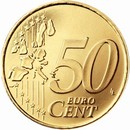 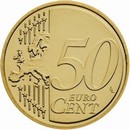  50 c |
Diameter (mm): 24.25 Thickness (mm): 2.38 Weight (g): 7.80 Shape: Round Colour: Yellow Composition: Nordic gold Edge: Shaped edge with fine scallops
|
||||
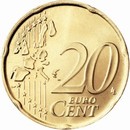 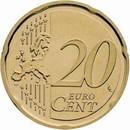  20 c |
Diameter (mm): 22.25 Thickness (mm): 2.14 Weight (g): 5.74 Shape: Spanish flower shape Colour: Yellow Composition: Nordic gold Edge: Plain
|
||||
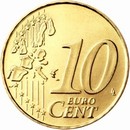 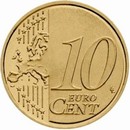  10 c |
Diameter (mm): 19.75 Thickness (mm): 1.93 Weight (g): 4.10 Shape: Round Colour: Yellow Composition: Nordic gold Edge: Shaped edge with fine scallops
|
||||
Coppered steelFor the coins of 1, 2 and 5 Euro cent red coloured coppered steel was chosen. This material is relatively cheap to produce and can be processed in the coin press without any problems. Moreover, the final coin is well protected against oxidation due to the protective copper layer. Unfortunately, the appearance of the coppered coins changes greatly during use due to contact with fingers. The red coloured gloss makes room for a deep brown colour that gives the design of the artist extra depth. Coins that circulate in payment remain expressive. Coins that are laid away shall however slowly and evenly discolour.Copper also has the unique characteristic of being a naturally antibacterial material. This hygienic aspect of copper is very well known and explains many of copper's other uses, such as doorknobs and handles in antiseptic environments like hospitals. Copper is fully recyclable, which in this time of increasing environmental consciousness, made it even more of a perfect choice for the currency. It is well known that the remelting and reuse of copper has been practiced since the Bronze Age. It is estimated that more than 80% of all the copper ever mined is still in use today and the value of scrap material, at the end of its useful life, will guarantee copper's future recycling. |
|||||
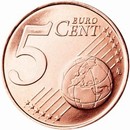  5 c |
Diameter (mm): 21.25 Thickness (mm): 1.67 Weight (g): 3.92 Shape: Round Colour: Red Composition: Copper-covered steel Edge: Smooth
|
||||
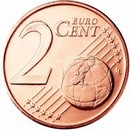  2 c |
Diameter (mm): 18.75 Thickness (mm): 1.67 Weight (g): 3.06 Shape: Round Colour: Red Composition: Copper-covered steel Edge: Smooth with a groove
|
||||
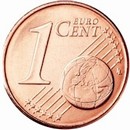  1 c |
Diameter (mm): 16.25 Thickness (mm): 1.67 Weight (g): 2.27 Shape: Round Colour: Red Composition: Copper covered steel Edge: Smooth
| ||||
|
No further changes will be made to the common side of the coins until 2007 at the earliest. Member states must keep their national reverse for five years. There are some exceptions, though. If the head of state of a country dies or abdicates, coins depicting the new one may be minted. There are no plans to move to common reverse issues in the nearly future. Even though the Euro was introduced as payment means in 2002, the production of Euro coins already started in 1999. Because the coins are provided with the year in which they are produced, the issue of Euro started with the year 1999. Years before the introduction of the Euro the coin masters of the European Union were intensively involved with the technical specifications of the new coins. Based on extensive research they made suggestions concerning the composition of the Euro coin series and the metals, dimensions, weight and edges to be selected. For these choices the requirement that coins should be easily distinguishable for blind people, and for use in machines was taken into account. Coin security featuresThe production of euro coins is carried out in accordance with specifications and characteristics of advanced technology. Therefore their reproduction becomes extremely difficult. Special care is taken for the incorporation of unique security features on €1 and €2 euro coins: Euro coins incorporate the most secure machine readable features and can be used in vending machines throughout the euro area, regardless of the issuing country. The coins of €1 and €2 are bi-metalic and their counterfeiting becomes extremely difficult, while lettering has been engraved around the edge of the €2 coin. | |||||
| Exchange rates | |||||
 |
Belgian Franc 40.3399 |
Deutsche Mark 1.95583 |
|||
| Greek Drachma 340.750 |
Spanish Peseta 166.386 |
||||
| French Franc 6.55957 |
Irish Pound 0.787564 |
||||
| Italian Lira 1936.27 |
Luxembourg Franc 40.3399 |
||||
| Dutch Guilder 2.20371 |
Austrian Schilling 13.7603 |
||||
| Portuguese Escudo 200.482 |
Finnish Markka 5.94573 |
||||
| Slovenian Tolar 239.640 |
Cypriot Pound 0.585274 |
||||
| Maltese Lira 0.429300 |
Slovakian Koruna 30.126 |
||||
Source: fleur-de-coin.com
Please wait, processing your request...








